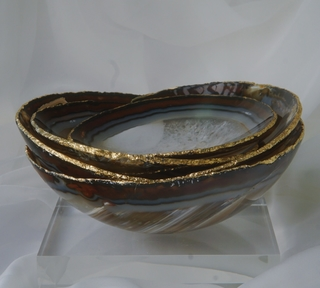Here we will help you learn a little more about how to clean precious stones and this will help you choose the best cleaning method.
It is worth remembering that these guidelines are for isolated gemstones. Products containing stones and any other material such as silver, bronze, leather, brass, metal, acrylic, wood, gold leaf finish or other fixing resins must follow the guidelines available in the “care, cleaning and conservation” menu.
Do you want to clean your jewelry but don't know how to do it? Knowing its pieces and the stones that make them up is the first step. Here we will talk a little about some of them and the possible ways to clean them, without damaging the parts.
Assume that, for most of them, warm water, neutral detergent and a soft or extra soft brush is a good start. However, before you decide to clean up your collection, add a little gemology knowledge to the mix.
The principle of everything is to identify and know your stones and gems. For each product we sell in the store, we identify the crystal and inform you at the time of purchase. If you have saved this information, as we indicate, it is easy, but if you have not saved it or cannot identify the gem, the best thing to do is to send the piece to a gemologist. He is a professional trained and qualified to identify the gems and, if you are interested, make a certificate for each gem he owns.
This identification is important because different gemstones have different physical properties and each requires a specific cleaning method, as they react differently to light, heat, acid, water and scratches.
So, let's talk about the hardness of gemstones. Contrary to what we might think, technically hardness is nothing more than the ability to resist scratches. It is not related to heat resistance or strength. This means that a high hardness does not mean that the stone is indestructible. It will just be more resistant to scratches than others. Therefore, it is recommended to store jewelry separately.
To classify the degree of hardness of stones and gems, we use the Mohs scale, which goes from 1 to 10, where diamond is the hardest stone found in nature at 10. Therefore, it has the ability to scratch all other gems and stones, including other diamonds. Thus, the higher the hardness, the greater its ability to cause scratches on the stones.
Associated with this, we can remember the hardness of some tools we use on a daily basis in relation to minerals:
|
MATERIAL |
MOHS |
RISK ABILITY |
|
Baby powder |
1 |
Can be scratched by a fingernail |
|
Gypsum |
two |
Can be scratched by a fingernail |
|
Nail |
two |
|
|
Calcite |
3 |
Can be scratched by a coin |
|
copper coin |
3 |
|
|
Fluorite |
4 |
Can be scratched by a pocket knife |
|
Switchblade |
5 |
|
|
Apatite |
5 |
Can be scratched by a pocket knife |
|
Glass |
5 - 6 |
|
|
Orthoclase |
6 |
Can be scratched by a steel file |
|
steel file |
6 |
|
|
Quartz |
7 |
Can scratch the glass |
|
Topaz |
8 |
Can scratch the quartz |
|
Corundum |
9 |
Can scratch topaz |
|
Diamond |
10 |
Can only be scratched by another diamond |
Another important point to consider is that, in terms of hardness, most household dust is made up of silica and therefore measures 7 - 7.5 on the Mohs scale. If you like to rub a cloth when dusting, be aware that this dust can scratch many of your stones and objects.
Below we will list different gemstones, their hardness and possible ways of cleaning and specific care.
|
EGG YOLK |
Mohs scale |
CLEANING TECHNIQUE |
COMMENTS |
|
Amber |
2 – 2.25 |
Wet and dry cloth |
Amber is an organic gemstone, a kind of hardened, fossilized form of ancient pine resin. |
| Amethyst |
7 |
Warm water, detergent and soft brush |
Most amethyst is heat treated for the best color, but it can crack and fade if exposed to high temperatures. |
|
Agate |
7 |
Warm water, detergent and soft brush |
Dyed agates lose their color over time. Keeping them away from salt, sun and heat helps keep their color longer. |
|
Aquamarine |
7.5 - 8 |
Warm water, detergent and soft brush |
This blue beryl can also be heat treated to enhance its blue color. Heat can cause color fading |
|
Carnelian |
7 |
damp cloth and then rub with a dry cloth |
Because wax does not stick to this tough variety of quartz, ancient people often used this material to make seals. |
|
Citrine |
7 |
Warm water, detergent and soft brush |
This heat treated quartz will fade when exposed to heat |
|
Emerald |
7.5 – 8 |
Warm water, detergent and soft brush |
Most emeralds are routinely bathed in hot oil after shaping to improve the color. Sometimes dyes are added. Mechanical systems can evaporate oil. Inclusions in emerald often weaken the stone. Therefore, mechanical systems can potentially cause breakdowns |
|
Grenade |
6 – 6.5 |
Warm water, detergent and soft brush |
|
|
Jade |
6.5 – 7 |
Warm water, detergent and soft brush |
Can withstand mechanical cleaning. However, acid treatments to improve color may weaken some samples. Ask a professional gemologist to examine all pieces to identify treatments. Both jade varieties can be polished to a high shine |
|
Malachite |
3.5 - 4 |
Cold water, detergent and soft brush |
The polish is shiny, but wear can cause the finish to dull. Rub vigorously with wood to help restore the finish. Sensitive to acid, ammonia, heat and hot water |
|
Pearl |
2.5 - 4.5 |
Clean with a soft, damp cloth. Remove stains with a mild soap solution on a cloth |
These organic gemstones require special care to look their best. They are vulnerable to scratches and sensitive to acids from perspiration. Never immerse in liquids. Never use ultrasound, steam or boiling for cleaning. Moisture trapped in the gem's holes often causes discoloration. |
|
Peridot |
6 – 7 |
Warm water, detergent and soft brush |
Acids (even from perspiration) and heat can damage peridot stones. Use with caution and protective settings as surface scratches will diminish the finish of this jewelry |
|
Turquoise |
5 – 6 |
Clean with a damp cloth and dry immediately |
Avoid cleaning this porous gem material with soap, detergents or cleaning solutions. They tend to penetrate the material, turning it unattractive green and/or blue. |
|
Topaz |
8 |
Warm water, detergent and soft brush |
Easy cleavage makes mechanical cleaning relatively dangerous for topaz. Both vibrations and heating can damage these gems |
|
Tourmaline |
7 – 7.5 |
Warm water, detergent and soft brush |
Although reasonably hard gemstones, tourmalines tend to be brittle. The pink variety can be structurally weak, therefore vulnerable to vibration damage. These gemstones are moderately sensitive to heat. Bicolor crystals sometimes split at color junctions |
Source: https://www.gemsociety.org/article/gemstone-care-guide
Regarding mechanical ways of cleaning, keep opal, pearl, emerald, tanzanite, coral, turquoise, malachite or amber away from an ultrasonic tank. If you choose to use ultrasound to clean other parts, follow the precautions below:
- Do not let the jewelry fall to the bottom of the stainless steel tank. Keep it suspended so that it floats in the liquid without touching the tank. Check the temperature of the liquid, as prolonged use of an ultrasonic cleaner can raise the temperature of the bath to unsafe levels. This will expose your yolks to thermal shock and can cause liquid-filled inclusions to break the yolk. Literally.
- Check the stones in your jewelry before and after cleaning. The vibrations can dislodge a loose rock so that it falls to the bottom of the tank.
- Use commercially prepared cleaning solutions intended for use in an ultrasonic cleaner.
When in doubt, look for a trusted professional to clean your gems.

